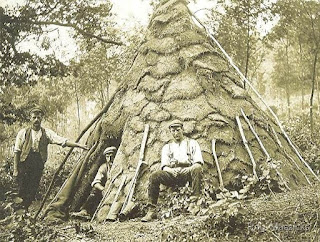WORMHOLES
getting lost on the net
Eric Ravilious - Drought
Wormholes. Do you ever disappear down them? I do, and I just have. As Blood on the Dunes is finished I'm having a break from writing and have been able to indulge in something else. I've long been a fan of the artist, Eric Ravilious, and came across one of his paintings I'd not seen before called Drought. It features an out-of-use steam roller with a living van, tar wagon and water bowser. I'd been planning a model railway layout based on another of his paintings, The Cement Works and thought the roller ensemble would make a nice little cameo on the layout.
Eric Ravilious - The Cement Pit 1
I already had a roller, I'd made from a kit, and a scratchbuilt living van, then I found an exquisite ready-made model of a tar cart on a model website. Now all need was a water bowser. The only ones available - in kit form or ready made were of a different pattern, and as I wanted to remain as faithful as possible to the picture, I would have to make my own.
I found a suitable photo and assembled the necessary components - a pair of wheels and little plastic vial. By combining these with some shaped styrene sheet and stiff wire I've fashioned a semblance of the water cart in the picture. Then, I disappeared down an internet wormhole.
I was struggling with resolving the shafts which must be used to pull the cart. In the painting they appear to be two parallel bars, suitable for a horse. This seemed strange as I assumed it would have been pulled by the roller. The other conundrum was the actual purpose of the wagon. Further digging revealed that there are two distinct types. One, is used for the sole purpose of transporting water, like this WW1 example.
The other, is for sprinkling water onto freshly laid tarmacadam, and this is the type in the painting. Luckily, as I travelled down the wormhole, I was able to find evidence of this in an article about the restoration of one at the Beamish Museum.
This clearly shows a box attached to the back, with holes drilled to distribute the water so this is what I will model. As to the shafts, do I leave them as is, or convert them so they can be towed by the roller?
















.jpeg)





